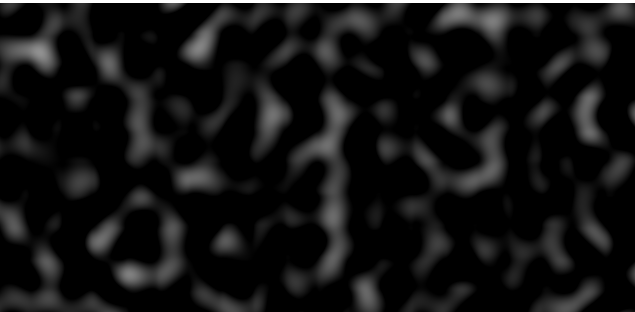普通的Perlin Noise
![]()
吐槽下:
比如用ti.random的时候,没有说明输出范围
函数明明可以返回vector,但文档里明确说不支持。
import taichi as ti
#ti.init(ti.cpu, debug=True)
ti.init(ti.cuda)
n=320
pixels=ti.var(dt=ti.f32,shape=(n*2,n))
CellSize = 0.1
TEX_COUNT = int(2/CellSize)+1
RANDOM_TBL = ti.Vector(2, dt=ti.f32, shape=(TEX_COUNT,TEX_COUNT))
RANDOM3_TBL = ti.Vector(3, dt=ti.f32, shape=(
TEX_COUNT,TEX_COUNT,TEX_COUNT))
@ti.func
def rand1dT1d(t:ti.template)->ti.template:
#ret = ti.sin(t*10+1.546)*143758.5453
#return ti.abs(ret-int(ret))
return RANDOM_TBL[t[0], t[1]]
@ti.func
def rand3dT3d(t:ti.template)->ti.template:
ret = ti.sin(t+0.546)*143758.5453
return ti.abs(ret-int(ret))
@ti.func
def easeIn(t:ti.template)->ti.template:
return t*t
@ti.func
def easeOut(t:ti.template)->ti.template:
return 1-easeIn(1-t)
@ti.func
def easeInOut(t:ti.template)->ti.template:
easeInValue = easeIn(t)
easeOutValue = easeOut(t)
return lerp(easeInValue, easeOutValue, t)
#return 6*(t**5)-15*(t**4)+10*(t**3)
@ti.func
def lerp(a:ti.template, b:ti.template, t:ti.f32)->ti.template:
return a*(1-t) + b*t
@ti.func
def gradientNoise(t:ti.template)->ti.f32:
fraction = t-int(t)
interpolator = easeInOut(fraction)
#return fraction.dot(fraction)
#return fraction[0]
ft = int(t)
ct = ti.cast(ti.ceil(t), ti.i32)
lowerleftd = rand1dT1d(ti.Vector([ft[0], ft[1]]))*2-1
#return (lowerleftd.dot(ti.Vector([1,1])))/2
#return lowerleftd[1]
lowerrightd = rand1dT1d(ti.Vector([ct[0], ft[1]]))*2-1
upleftd = rand1dT1d(ti.Vector([ft[0], ct[1]]))*2-1
uprightd = rand1dT1d(ti.Vector([ct[0], ct[1]]))*2-1
lowleftv = lowerleftd.dot(fraction-ti.Vector([0, 0]))
lowrightv = lowerrightd.dot(fraction-ti.Vector([1, 0]))
#-return ti.abs(lowleftv)
upleftv = upleftd.dot(fraction-ti.Vector([0, 1]))
uprightv= uprightd.dot(fraction-ti.Vector([1, 1]))
low = lerp(lowleftv, lowrightv, interpolator[0])
#return low
up = lerp(upleftv, uprightv, interpolator[0])
#return low
noise = lerp(low, up, interpolator[1])
return noise
@ti.func
def gradientNoise3D(t:ti.template)->ti.f32:
fraction = t-int(t)
interpolator = easeInOut(fraction)
cellNoiseZ = ti.Vector([0.0,0.0,0.0])
for z in ti.static(range(2)):
cellNoiseY = ti.Vector([0.0,0.0,0.0])
for y in ti.static(range(2)):
cellNoiseX = ti.Vector([0.0,0.0,0.0])
for x in ti.static(range(2)):
cell = int(t) + ti.Vector([x, y, z])
cellDirection = RANDOM3_TBL[cell[0], cell[1], cell[2]]*2-1
# cellDirection = rand3dT3d(cell)*2-1
compareVector = fraction - ti.Vector([x, y, z])
cellNoiseX[x] = cellDirection.dot(compareVector)
# return cellDirection.dot(compareVector)
#return cellNoiseX[x]
cellNoiseY[y] = lerp(cellNoiseX[0], cellNoiseX[1], interpolator[0])
cellNoiseZ[z] = lerp(cellNoiseY[0], cellNoiseY[1], interpolator[1])
noise = lerp(cellNoiseZ[0], cellNoiseZ[1], interpolator[2])
return noise
#return previousLinePoint*interpolator + nextLinePoint*(1-interpolator)
@ti.func
def complex_sqr(z):
return ti.Vector([z[0]**2-z[1]**2,z[1]*z[0]*2])
@ti.kernel
def paint(t:ti.f32):
for i,j in pixels:#Parallized over all pixels
pos = ti.Vector([i,j])
pixels[i,j]= gradientNoise(pos/n / CellSize) #1-iterations*0.02
@ti.kernel
def paint3d(t:ti.f32):
for i,j in pixels:#Parallized over all pixels
pos = ti.Vector([i,j,t])
noise = gradientNoise3D(pos/n / CellSize) #1-iterations*0.02
noise += 0.5
noise *= 6
noise = (noise-int(noise))
if noise < 0.9:
noise = 0
pixels[i,j] = noise
@ti.kernel
def generate_random():
for i in range(TEX_COUNT):
for j in range(TEX_COUNT):
RANDOM_TBL[i,j] = ti.Vector([ti.random(), ti.random()])
for i in range(TEX_COUNT):
for j in range(TEX_COUNT):
for k in range(TEX_COUNT):
RANDOM3_TBL[i,j, k] = ti.Vector([ti.random(), ti.random(), ti.random()])
generate_random()
gui=ti.GUI("JuliaSet",res=(n*2,n))
for i in range(1000000):
# paint(i*0.3)
paint3d((i*0.3) % (n*2))
gui.set_image(pixels)
gui.show()
